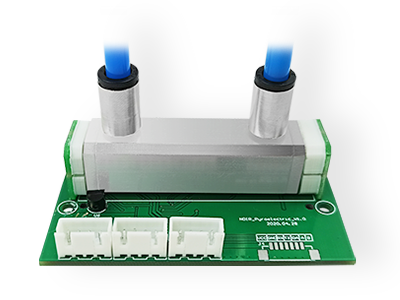An infrared gas sensor, or an IR gas sensor, is a type of sensor that detects the presence of gas molecules within a particular area based on the principle of absorption of electromagnetic radiation in the infrared range. Infrared radiation is a type of electromagnetic radiation whose wavelength is longer than the visible light, but shorter than that of radio waves. The wavelength range of the infrared radiation is from 750 nm to 1 mm.
The basic working principle of an IR gas sensor is that it uses a source of infrared radiation, such as a lamp, and a detector of the same type of radiation, typically a photodiode, to measure the amount of infrared radiation transmitted through a sample of gas under test. When a gas molecule absorbs infrared radiation, it undergoes a transition to a higher energy state. The molecule then releases the energy in the form of heat and/or by re-emitting the infrared radiation at a longer wavelength. This phenomenon is called absorption and re-emission of infrared radiation.
An IR gas sensor is designed to measure the intensity of absorbed and re-emitted radiation by a sample of gas. The ratio of the intensity of the absorbed and re-emitted radiation at different wavelengths is used to calculate the concentration of gas molecules within the sample. Most commercial IR gas sensors have a wavelength range between 2.5 µm and 7.5 µm, allowing them to detect a wide range of gas types, including but not limited to carbon dioxide, flammable gases, and toxic gases.
Advantages of IR Gas Sensors
IR gas sensors offer significant advantages over other types of gas sensors, such as electrochemical and catalytic sensors. One of the main advantages of IR gas sensors is their high selectivity of gas detection. IR sensors only detect gas molecules that absorb radiation at specific wavelengths, which makes it easier to distinguish between different gas molecules and improve the accuracy of their concentration measurements.
Another advantage of IR gas sensors is their long operational life. Since IR sensors don't require any chemical reactions during gas detection, they don't suffer from depletion of reagents over time, which is a common problem with electrochemical and catalytic sensors.
IR sensors also have a fast response time, typically measured in seconds. This is because the absorption and re-emission of infrared radiation occur very rapidly. Additionally, IR sensors don't require any warm-up time, as required by catalytic sensors.
Applications of IR Gas Sensors
IR gas sensors find applications in various industries, including but not limited to environmental monitoring, industrial process control, mining safety, and medical gas analysis.
Environmental Monitoring: Infrared gas sensors are used in environmental monitoring to detect the concentrations of various gases in the atmosphere, including carbon dioxide, methane, and nitrous oxide, which are important indicators of global warming and climate change. IR sensors can also be used to measure the emissions of greenhouse gases from industrial sources, such as power plants and refineries.
Industrial Process Control: IR gas sensors are used in industrial processes to monitor the concentrations of gas molecules during various manufacturing processes. For example, IR sensors can detect the presence of volatile organic compounds (VOCs) in the fumes released from paint booths and printing presses.
Mining Safety: IR gas sensors are used in the mining industry to detect the presence of toxic gases, such as carbon monoxide and methane, which are generated during the mining process. IR sensors can also be used to monitor the concentration of oxygen in the air to prevent suffocation and other hazards.
Medical Gas Analysis: IR gas sensors are used in medical settings to monitor the concentrations of various gases used in the anesthesia and other medical procedures. IR sensors can detect the presence of gases such as nitrous oxide, carbon dioxide, and oxygen.
Conclusion
Infrared gas sensors are highly useful tools for detecting the presence of various gas molecules in different environments. They offer many advantages over other types of gas sensors, including fast response times, high selectivity, and long operational life. IR gas sensors are used in a broad range of applications, from environmental monitoring and industrial process control to mining safety and medical gas analysis. As technology continues to improve, we can expect IR gas sensors to become even more advanced, reliable, and efficient.
 : +86 155 8830 2704
: +86 155 8830 2704 : jxdziot@gmail.com
: jxdziot@gmail.com
